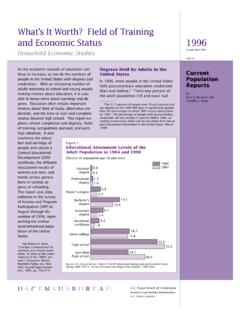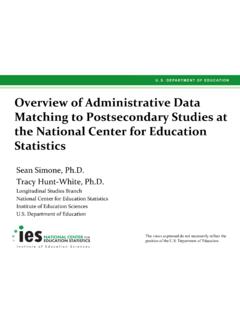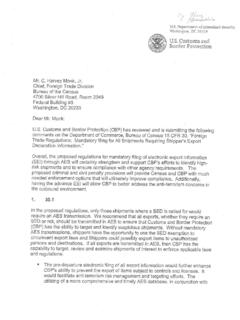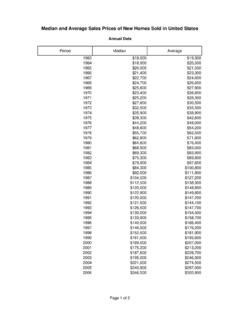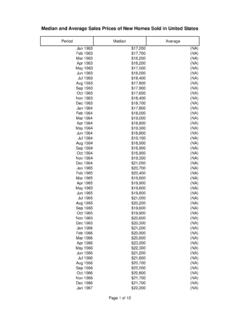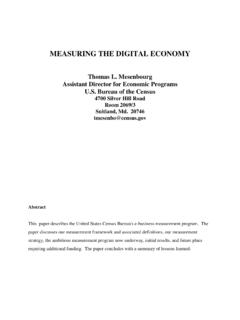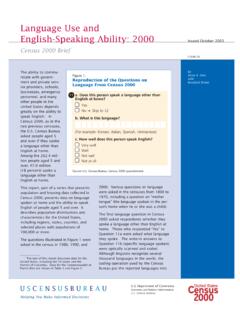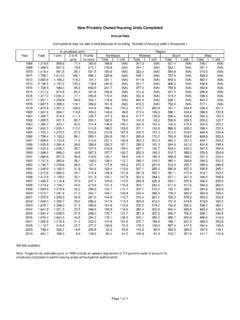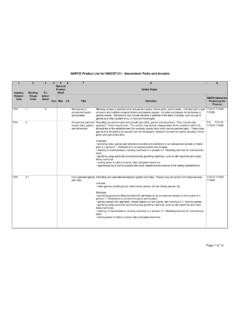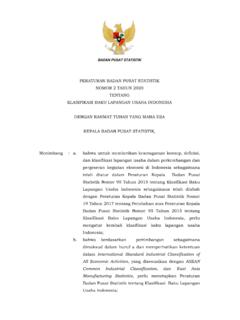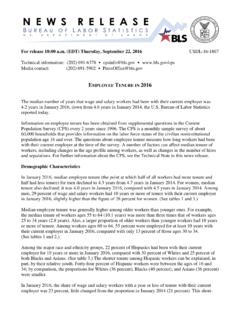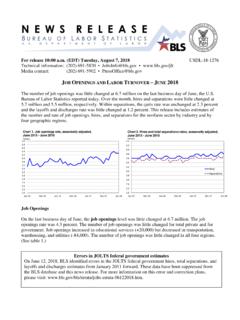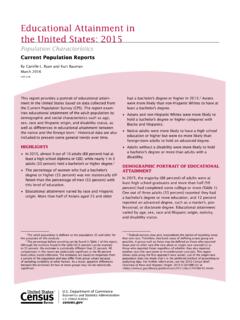Transcription of Advance Economic Indicators Report - February 2022
1 FOR RELEASE AT 8:30 AM EDT, THURSDAY, JUNE 25, 2020. MONTHLY Advance Economic Indicators Report , MAY 2020. Release Number: CB20-97. Statement Regarding COVID-19 Impact: Due to recent events surrounding COVID-19, many businesses are operating on a limited capacity or have ceased operations completely. The Census Bureau has monitored response and data quality and determined estimates in this release meet publication standards. For more information on the compilation of this month's Report , see <COVID-19 FAQs>. June 25, 2020 The Census Bureau announced the following international trade, wholesale inventories, and retail inventories Advance statistics for May 2020: Advance Advance Advance . INTERNATIONAL WHOLESALE RETAIL. TRADE: GOODS DEFICIT INVENTORIES INVENTORIES.
2 MAY 2020 $ Billion + $ Billion $ Billion APRIL 2020 $ Billion $ Billion (R) $ Billion (R). Next release: July 29, 2020. * The 90 percent confidence interval includes zero. There is insufficient evidence to conclude that the actual change is different from zero. Statistical significance is not applicable or not measurable. Data adjusted for seasonality but not price changes. Source: Census Bureau; Advance Economic Indicators Report , June 25, 2020. Advance International Trade in Goods The international trade deficit was $ billion in May, up $ billion from $ billion in April. Exports of goods for May were $ billion, $ billion less than April exports. Imports of goods for May were $ billion, $ billion less than April imports. Advance Wholesale Inventories Wholesale inventories for May, adjusted for seasonal variations but not for price changes, were estimated at an end-of-month level of $ billion, down percent ( percent) from April 2020, and were down percent ( percent) from May 2019.
3 The March 2020 to April 2020 percentage change was revised from up percent ( percent) to up percent ( percent)*. Advance Retail Inventories Retail inventories for May, adjusted for seasonal variations but not for price changes, were estimated at an end-of- month level of $ billion, down percent ( percent) from April 2020, and were down percent ( percent) from May 2019. The March 2020 to April 2020 percentage change was revised from down percent ( percent) to down percent ( percent). Data Inquiries Media Inquiries International Trade Indicator Branch: 301-763-2311 Public Information Office Retail Indicator Branch: 301-763-2713 301-763-3030. Wholesale Indicator Branch: 301-763-6856 The June 2020 Advance Report is scheduled for release on July 29, 2020.
4 View the full schedule in the Economic Briefing Room: < >. The full text and tables of this release can be found at < >. EXPLANATORY NOTES. International Trade in Goods Goods (Census Basis). Data for goods on a Census basis are compiled from the documents collected by the Customs and Border Protection and reflect the movement of goods between foreign countries and the 50 states, the District of Columbia, Puerto Rico, the Virgin Islands, and Foreign Trade Zones. They include government and non-government shipments of goods and exclude shipments between the United States and its territories and possessions;. transactions with military, diplomatic, and consular installations abroad; goods returned to the United States by its Armed Forces; personal and household effects of travelers; and in-transit shipments.
5 Data for exports to Canada are derived from import data compiled by Canada. For more information on the data exchange and substitution please refer to the FT-900. The General Imports value reflects the total arrival of merchandise from foreign countries that immediately enters consumption channels, warehouses, or Foreign Trade Zones. For imports, the value reported is the Customs and Border Protection appraised value of merchandise . generally, the price paid for merchandise for export to the United States. Import duties, freight, insurance, and other charges incurred in bringing merchandise to the United States are excluded. Exports are valued at the free alongside ship value of merchandise at the port of export, based on the transaction price including inland freight, insurance, and other charges incurred in placing the merchandise alongside the carrier at the port of exportation.
6 Additional information on coverage and valuation are available in the Guide to Foreign Trade Statistics, < #coverage> and < trade/ #valuation>, respectively. Nonsampling Errors Goods data are a complete enumeration of documents collected by the Customs and Border Protection and are not subject to sampling errors. This Report presents current month statistics which reflect nearly complete coverage. Current month statistics reflecting complete coverage will be published in the upcoming International Trade in Goods and Services Report (FT-900). Statistics for other months shown reflect complete coverage and appear in the most recently published FT-900. Quality assurance procedures are performed at every stage of collection, processing, and tabulation.
7 However, the data are still subject to several types of nonsampling errors. Information on nonsampling errors and other quality issues are available in the Guide to Foreign Trade Statistics, < >. Data Inquiries Media Inquiries International Trade Indicator Branch: 301-763-2311 Public Information Office Retail Indicator Branch: 301-763-2713 301-763-3030. Wholesale Indicator Branch: 301-763-6856 The Census Bureau recommends that data users incorporate this information into their analyses, as nonsampling errors could impact the conclusion drawn from the results. For a detailed discussion of errors affecting the goods data, see Merchandise Trade Statistics: A Quality Profile (October 2014), available at < > or from the Economic Indicators Division, Census Bureau.
8 Adjustments for Seasonal and Trading-Day Variations Goods data are presented on a seasonally adjusted and not seasonally adjusted basis. Seasonally adjusted (and/or trading day adjusted data) are produced using X-13 ARIMA-SEATS software to develop monthly adjustment factors. Goods data are initially classified under the Harmonized Commodity Description and Coding System (Harmonized System), which is an internationally accepted standard for the commodity classification of traded goods. Combining trade into approximately 140 export and 140 import end-use categories makes it possible to examine goods according to their principal uses. These categories are used as the basis for computing the seasonal and trading-day adjusted data. These adjusted data are then summed to the six end-use aggregates for publication.
9 For more information, visit the seasonal adjustment section of the Guide to Foreign Trade here: < #seasonal>. Retail and Wholesale Inventories National estimates of end-of-month inventories are based on data from the Monthly Retail Trade Survey and the Monthly Wholesale Trade Survey. Additional information for each survey can be found at < >. and < >. The Advance estimates contained in this Report are not incorporated into the full MRTS and MWTS time series. The MRTS and MWTS samples selected to measure inventories consist of a stratified simple random sampling method of approximately 11,000 retail firms and 4,200 wholesale firms located in the United States. The retail and wholesale samples include firms of all sizes and are updated on a quarterly basis to account for new retail and wholesale firms, deaths, and other changes to the universe.
10 Data for nonresponding firms are imputed based on data for similar-sized firms classified in the same kind of business. For surveyed Retail companies, approximately percent provided data for this reporting period resulting in a total quantity response rate of percent. For surveyed Wholesale companies, approximately percent provided data for this reporting period resulting in a total quantity response rate of percent. MRTS estimates cover companies with one or more establishments that sell merchandise and related services to final consumers. Nonemployers are represented in the retail estimates through benchmarking to prior annual survey estimates that include nonemployer sales based on administrative records. MWTS estimates cover wholesale merchants who sell goods on their own account and include such businesses as wholesale merchants or jobbers, industrial distributors, exporters, and importers.
